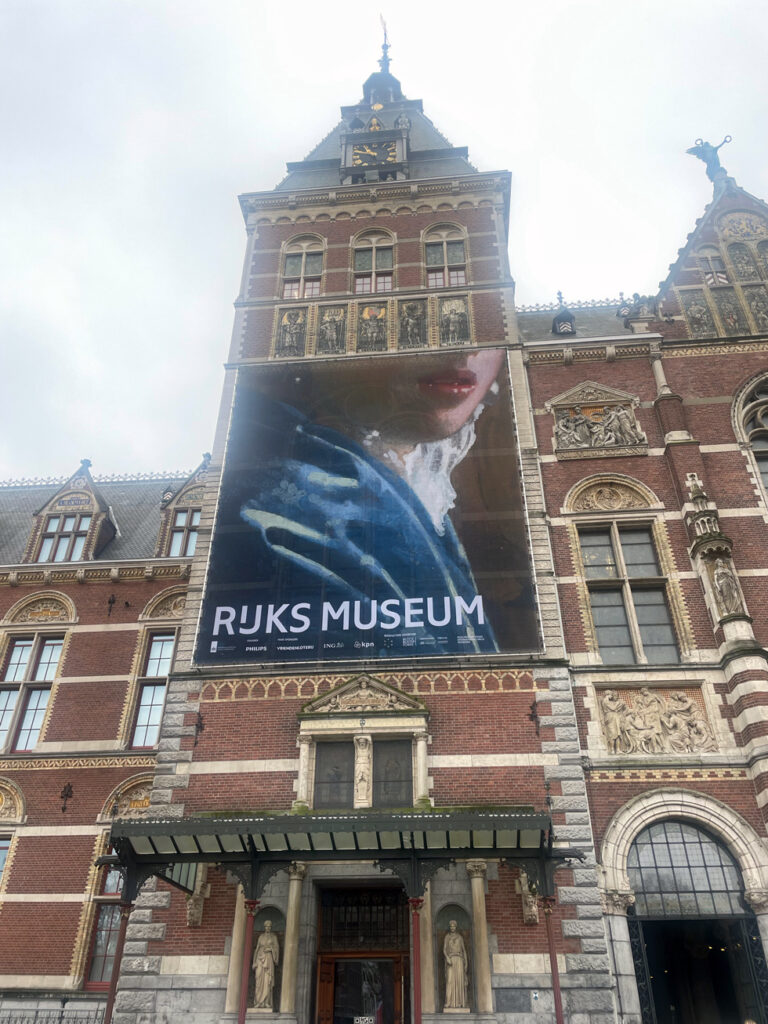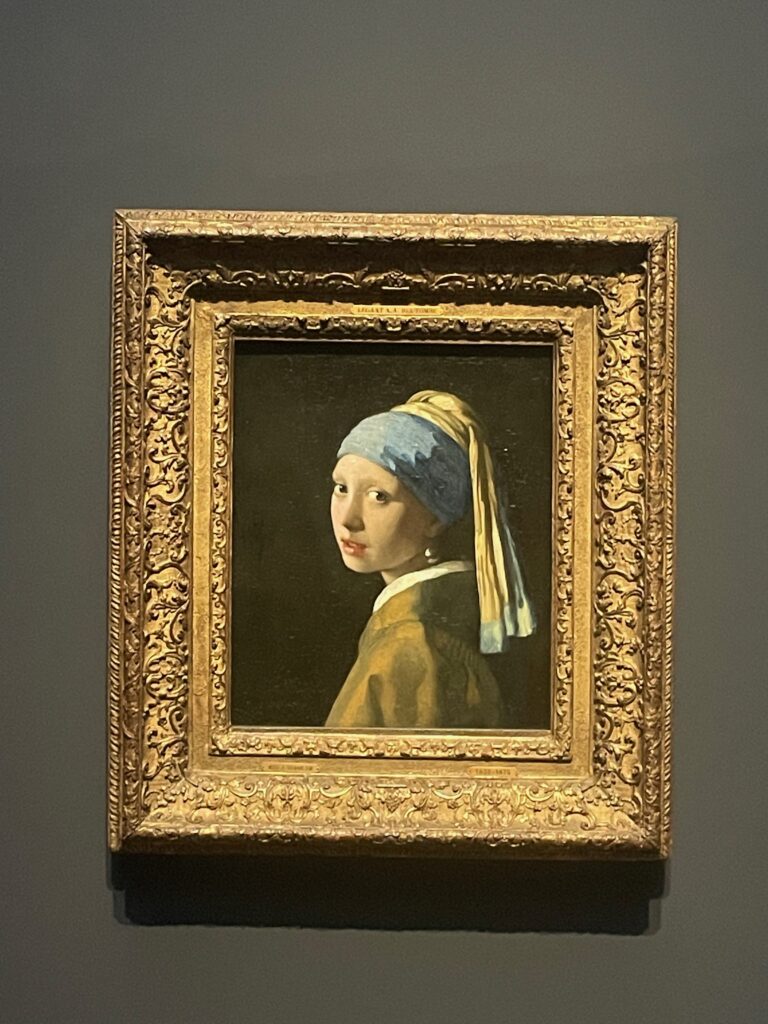Words by Jessica Hartley
Culturalee visited Amsterdam to review the Vermeer exhibition at the Rijkmuseum and stayed at the Pulitzer Hotel. Such is the star power of 17 th Century Dutch painter Johannes Vermeer that he is one of a select few artists from the pantheon of art history known on a first name base, rather like an art world version of Beyoncé or Rihanna.
So when the Rijksmuseum announced the biggest ever exhibition of Vermeer in history, the clamour to book tickets was similar to trying to get tickets for a Harry Styles concert, and the show sold out (all 200,000 tickets) only a couple of days after opening. There was so much hype surrounding the exhibition that a Dutch reality TV show called ‘The New Vermeer’ was launched, hosted by Rijksmuseum curator Pieter Roelofs, and featuring amateur and professional artists competing to recreate some of the Old Master’s lost artworks.

The pièce de resistance of the exhibition was ‘Girl with a Pearl earring’, subject of many books including Tracy Chevalier’s 1991 novel and subsequent film, and a painting that really doesn’t disappoint if you can get up close. It’s completely captivating, luminous, ethereal, and has the effect of making you want to reach out and touch the translucent skin of the sitter, reputed to be Griet, a 16-year-old Dutch maid who worked for Vermeer. Such is the magic of this sublime painting that it has a similar effect on the senses as Leonardo da Vinci’s iconic ‘Mona Lisa’, attracting visitors at the Rijksmuseum towards the canvas with an inescapable magnetism.
Each of the paintings on display in this once-in-a-lifetime exhibition has a similarly magical quality, and it’s difficult to comprehend how Vermeer used paint to create such life-like time capsules that truly transport the onlooker into the privileged world of the middle classes in 17th Century Holland. The 28 paintings are given room to breathe by spreading them across 10 rooms of the Rijksmuseum, commencing with street views via scenes depicting religious narratives or classical mythology to paintings of Dutch 17th Century domestic interiors. Rijksmuseum co-curators Gregor J.M. Weber and Pieter Roelofs have curated the exhibition to focus on Vermeer’s interest in optical science, his Catholic faith and association with the Jesuits.
Unfortunately the exhibition was so busy that it was difficult to get up close to the canvas before being obstructed by a camera phone, or feeling obligated to move on to the next painting as a queue builds up behind you. It’s not quite the same level of hysteria as trying to catch a glimpse of da Vinci’s ‘La Jocande’ at the Louvre in Paris, but you will need to penetrate a small army of people jostling to get close to the paintings whilst many hold their phones in the air in front of the paintings instead of actually looking at them with their own eyes. Vermeer’s paintings have achieved an almost deity-like status, with art pilgrims eager to capture the moment on their iphones, but missing the point of seeing the paintings in real life, for his gift of creating such hyperreal illusions of domestic scenes, is something that needs to be observed with the eyes and not diluted by a screen.
The curation and production design of the exhibition had a theatrical quality, which complemented the interior drama of the paintings, which are displayed on charcoal-coloured walls, and separated with dark curtains falling from ceiling to floor. Each painting was displayed in its own separate area, inviting visitors to approach the canvases almost as if they were altar-pieces in a church. Perhaps this was an intentional curatorial decision, since Vermeer is known to have been a devout Catholic with close ties to the Jesuits.

Johannes Vermeer (1632-1675) lived and worked in Delft, achieving success during his lifetime and becoming known for a mastery of light and illusion conveyed through tranquil domestic scenes depicting solitary figures. Vermeer the man was something of an enigma, and there are no self-portraits of him, although one the early works featured in the exhibition – ‘The Procuress’ – features a man on the left side of the canvas gazing out at the viewer, which could be the artist, as the tradition in Dutch painting of the period was that the artist often positioned himself on the edge of a scene.
According to Pieter Roelofs, art historians accept 37 paintings as autographed works by Vermeer, of which 24 are signed and 5 are also dated. Vermeer’s 1664 painting ‘The Concert’ was stolen from the Isabella Stewart Gardner in Boston, Massachusetts in 1990. Experts believe that Vermeer painted between 45-50 paintings during the third quarter of the 17th Century, over a period of over two decades, a relatively low output compared to his contemporary Rembrandt, who is reputed to have painted more than 350 paintings. The small number of Vermeer paintings in existence makes the Rijksmuseum’s exhibition a once in a lifetime chance to view 28 of 37 paintings in existence that are attributed to Vermeer.
The exhibition was only made possible through generous loans from the Frick Collection in New York (‘Mistress and Maid’), the Musée du Louvre in Paris (‘The Lacemaker’), the Metropolitan Museum of Art in New York (Young Woman with a Lute), Mauritshuis in The Hague (‘The Girl with a Pearl Earring’), Frankfurt’s Städel Museum (‘The Geographer’), the National Gallery of Ireland (‘Lady Writing a Letter with her Maid’), and The National Gallery of Art, Washington DC (‘Woman Holding a Balance’). Works never before shown to the public in the Netherlands will include the newly restored ‘Girl Reading a Letter at the Open Window’, loaned by the Gemäldegalerie Alte Meister in Dresden.
The hyperbole surrounding the exhibition was somewhat justified, for it was no small feat to amass such a large collection of Vermeer’s paintings in one place, especially considering they are priceless and seldom allowed to travel on loan due to their fragility and the sky-high price of insurance.

On display at the Rijksmuseum were world-famous and much-reproduced masterpieces ‘Girl with a Pearl Earring’ and ‘The Milkmaid’, as well as ‘View of Delft’ (Vermeer’s only landscape painting depicting his birthplace of Delft), ‘Diana and her Nymphs’ and ‘Girl with a flute’, which was recently confirmed as a Vermeer. Vermeer was a master of illusion, adept at creating his own world in a painting, and that world is usually populated by contemplative sitters without much movement, and with great attention to the detail of the furnishings and details of the interiors, and clothes of the subjects, which combines to create a feeling of tranquility and quiet observation.
Experts now believe that Vermeer achieved such realism by using a camera obscura, an early optical device that projects photographic images onto the interior wall of a darkened box, bringing some parts of a composition into focus whilst others are blurred. The camera obscura also intensified colours, and was invented by Antony van Leeuwenhoek, inventor of the microscope, who happened to be the executor of Vermeer’s will.
Gregor J.M. Weber: “Among the most conspicuous qualities of Vermeer’s art are the much-admired inwardness and tranquility of his figural scenes. His interiors seem to be isolated from the outside world, as if their inhabitants might exist in their domestic worlds entirely on their own and for themselves.”
Vermeer captured everyday secular scenes of Dutch 17th Century domestic life which are featured in the exhibition, as well as religious scenes such as ‘Christ in the House of Mary and Martha’, and stories taken from Greek mythology, for example ‘Diana and her Nymphs’. However not every painting is a picture of serenity, and his 1655 painting (possibly his earliest surviving work) ‘Saint Praxedis’ shows a woman calmly squeezing blood from a sponge into a vessel in the foreground, with a dead corpse of a man in the background, his arm decapitated at the shoulder. ‘Saint Praxedis’ was authenticated as a Vermeer by Christie’s in 2014 and is thought to be a copy of a painting by Felice Ficherelli (1640–45) in the Collection Fergnani in Ferrara, which depicts the early Roman Martyr.

Culturalee stayed at the Pulitzer Amsterdam, a luxurious hotel comprised of 25 Golden Age canal houses, situated on the beautiful Prinsengracht canal. The Pulitzer is located in the UNESCO world heritage city centre and takes its name from Joseph Pulitzer, founder of the Pulitzer Prize, whose grandson Peter Pulitzer bought 12 houses on Prinsengracht and Keizersgracht in 1960 and transformed them into a five-star hotel.
In 2016 Creative Director Jacu Strauss reimagined the Pulitzer Amsterdam’s design details throughout each of Pulitzer’s 225 rooms and suites, which are inspired by residents of the past four centuries from artists and antiques collectors to writers and musicians.
Dinner was in the hotel’s Jansz restaurant, which serves modern Dutch, locally sourced cuisine. An enthusiastic young waiter who was more like a sommelier in his knowledge of wine, gave expert advice on the menu and the Chefs turned out the most delicious dishes of Amsterdam-style Oysters and Eringi with Truffle and Reypenaer. The hotel launched a partnership with the Rijksmuseum to coincide with the largest exhibition of works by Johannes Vermeer ever to be displayed. The Pulitzer is walking distance from Rijksmuseum to Stedelijk Museum, the Van Gogh Museum and the Anne Frank House.
‘Rijksmuseum: https://www.rijksmuseum.nl/en
Culturalee stayed at the Pulitzer Amsterdam: https://www.pulitzeramsterdam.com



